NDQ vs VGS: Harnessing Tech Potential And Global Opportunities
Last Updated on 30 March 2024 by Ryan Oldnall
International investing has been profitable for Australian investors in recent years, particularly with the US experiencing a bull market since October 2022[1]. With substantial gains, investors have turned to options like NDQ to capitalize on this growth, with notable performers like Nvidia boasting a 277.16% increase within the past year[2].
In this article, we will compare Betashares Nasdaq 100 ETF (NDQ), a relatively concentrated ETF, against Vanguard MSCI Index International Shares ETF (VGS), a well-diversified ETF option.
These ETFs not only differ in the indices they track but also in their underlying holdings and market exposures.
Using data from Yahoo Finance and Morningstar, we’ll analyze the performance of both NDQ and VGS, exploring the factors influencing their respective performances [3][4].
NDQ ETF Review
Pros
Cons
The Nasdaq 100 ETF, or NDQ, emerges as a preferred investment for those seeking to capitalize on the growth potential of the NASDAQ 100 Index. NDQ is designed to mirror the performance of the Nasdaq 100 Index, offering investors direct exposure to the market movements of leading tech companies.
Comprising 100 of the most influential non-financial companies listed on the Nasdaq market, the Nasdaq 100 includes tech giants such as Amazon, Microsoft, Apple, and Google (Alphabet).
NDQ was introduced on May 26, 2015, and has consistently delivered strong performance on the ASX since its inception.
In my analysis of the top-performing ETFs in Australia over the past 5 years, NDQ emerged as the standout performer, demonstrating its resilience and potential for long-term growth.
BetaShares, the parent company of NDQ, operates on a smaller scale compared to VGS’ parent company, Vanguard. Established in 2009, BetaShares manages around 1 million investments and $35 billion in assets under management, offering 95 ETFs on the Australian ETF market [6].
VGS ETF Review
Pros
Cons
Vanguard, a multinational investment management firm, has had significant influence in the Australian market since its establishment in 1996.
Vanguard, which has over 50 million investors globally, manages a total of over A$10 trillion in assets, with its Vanguard MSCI Index International Shares ETF (VGS) alone having $6.8 billion invested in it [7][8].
The Vanguard MSCI Index International Shares ETF, known as VGS, made its debut on November 18, 2014. VGS seeks to replicate the performance of the MSCI World ex-Australia index, providing investors with exposure to the largest companies in numerous developed countries.
VGS invests in approximately 1,500 companies from developed countries, excluding Australia. It includes companies from about 23 different countries, such as the US, Japan, UK, Canada, France, and Switzerland [8].
When it comes to size, VGS significantly surpasses NDQ, with $6.8 billion invested in the ETF compared to NDQ’s $4.3 billion. However, even when their assets are combined, both ETFs still fall short of Australia’s largest ETF, Vanguard Australian Shares Index ETF, VAS.

NDQ vs VGS Management Expense Ratio (ETF Management Fees)
Management fees, or Management Expense Ratios (MERs), are important when evaluating ETF investments. ETFs aim to track their underlying indices closely, but it’s essential to consider fees and expenses as they can impact returns.
Comparing the management fees of NDQ and VGS, VGS stands out as the more cost-effective option, with a management expense ratio of 0.18%. This represents excellent value considering the broad exposure VGS offers across multiple countries and sectors.
On the other hand, NDQ has a higher management expense ratio of 0.48%, which is 2.5 times that of VGS. Despite this, many investors find NDQ’s performance over the past 5 years justifies its higher fee.
To put these costs into perspective, for every $10,000 invested, VGS would incur a fee of $18, while NDQ would cost $48.
I’ve previously explored ETF fees using ASX data in an article titled Who Has The Lowest ETF Management Fees In Australia?, focusing solely on Australian-domiciled ETFs.
NDQ VS VGS – Performance Chart
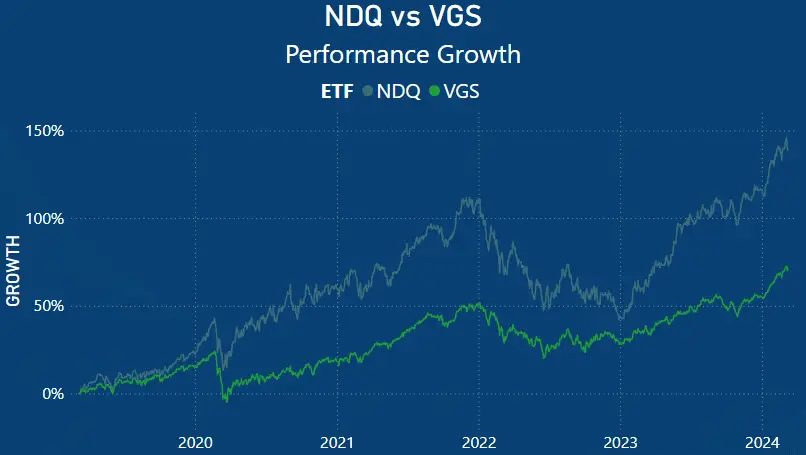
NDQ VS VGS – Annualised Returns
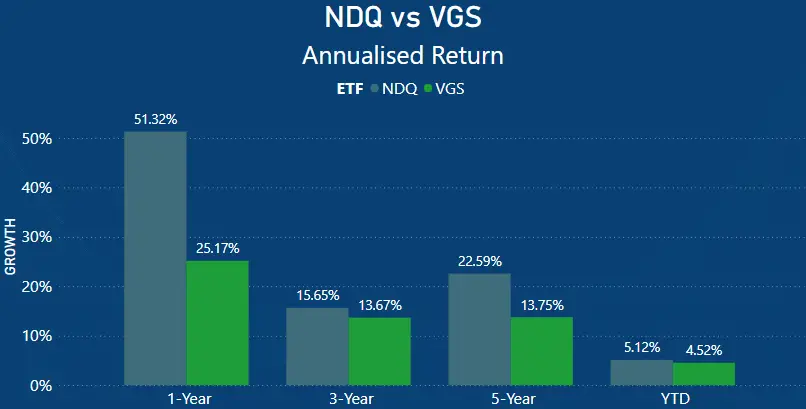
When comparing the performances of NDQ and VGS, a clear winner emerges for both the short and longer term. While their year-to-date (YTD) performances are comparable, in the longer term, NDQ outperforms VGS by a significant margin.
The year-to-date performance of NDQ has yielded 5.12%, slightly ahead of VGS at 4.52%. However, the margins widen considerably due in part to NDQ’s outstanding 1-year performance.
NDQ’s 1-year performance is double that of VGS, standing at 51.32%, while VGS achieved a 1-year performance return of 25.17%. To provide context, the total return of the ASX over the same period was 12.16% [9].
Looking at the 3-year annualized performances, NDQ returned 15.65%, which was 1.98% higher than VGS’ return of 13.67% on average over 3 years.
Finally, in the medium term of 5 years, both have performed robustly, with NDQ achieving a much higher average return of 22.59% over 5 years. VGS saw a slight improvement over its 3-year annualized return, with an increase of 0.08% to a 5-year annualized return of 13.75%.
In a recent review of ASX performance data, NDQ was found to be the best-performing ETF on average over a 5-year period.
NDQ Top 10 Holdings
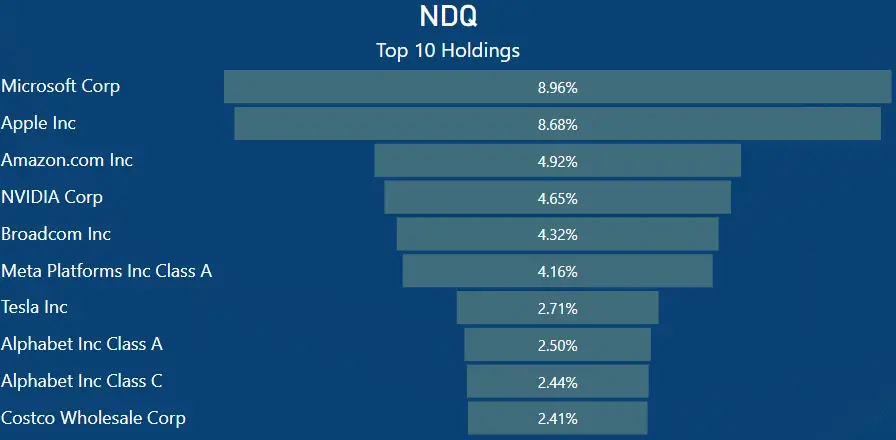
As expected, NDQ is heavily weighted in technology stocks. The NASDAQ 100 index comprises the 100 largest non-financial companies listed on the NASDAQ stock exchange.
While this index allows for the inclusion of non-financial companies, a significant portion of the stocks listed are technology-based. When you invest in NDQ, you’re also investing in companies like Microsoft, which makes up 8.89% of the index, Apple at 8.68%, Amazon at 4.92%, and Nvidia at 4.65%.
In practical terms, a $1000 investment in NDQ would allocate approximately $89.60 to Microsoft stocks, $86.80 to Apple, $49.20 to Amazon, and $46.50 to Nvidia.
VGS Top 10 Holdings
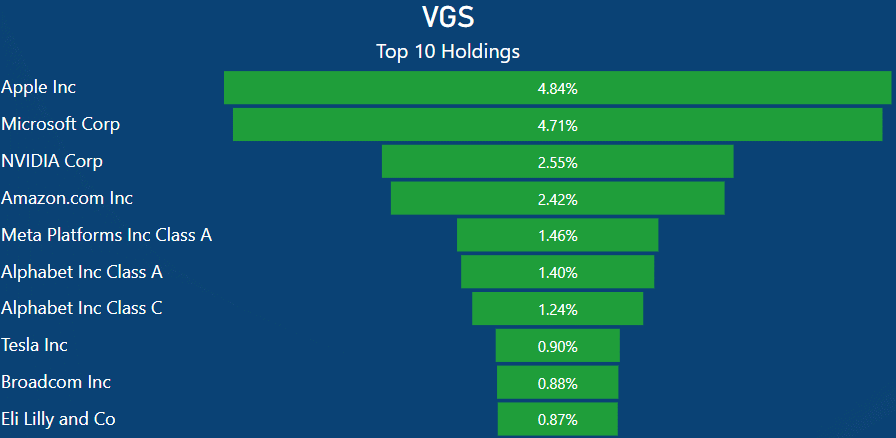
When comparing the top 10 holdings of VGS to those of NDQ, they are remarkably similar. Nine out of the top 10 holdings are identical, albeit with different weightings. The only variation in stock holding is the inclusion of Eli Lilly and Co at the expense of Costco.
For a global ETF, many might be surprised at these top holdings considering the ETF’s worldwide scope. However, as discussed in previous articles related to VGS, a significant portion of the ETF comprises US-based stocks. This is due to the size of the US stock market and the relative dominance of US companies globally.
When you invest $1000 in VGS, you effectively allocate approximately $48.40 to Apple, $47.10 to Microsoft, and $25.50 to Nvidia.
VGS vs NDQ Top 10 Holdings As A Total Percentage Of ETF
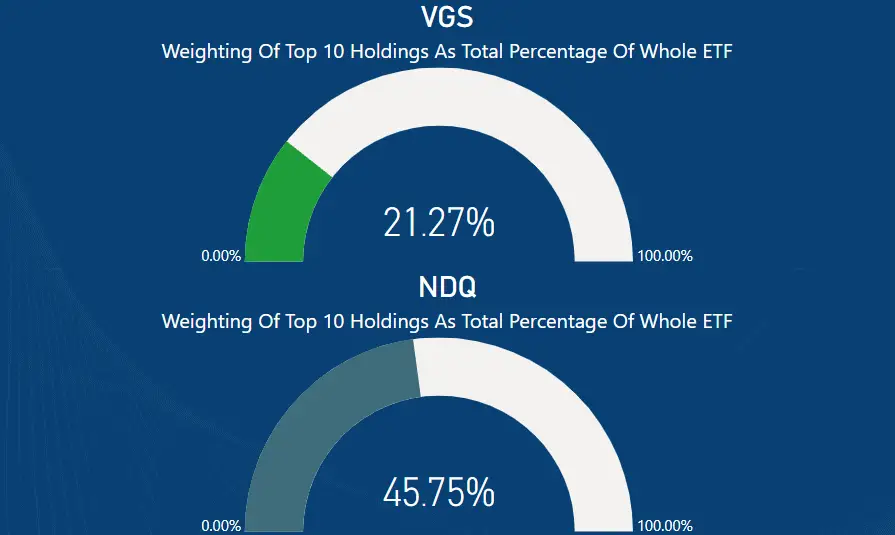
When comparing the top 10 holdings as a percentage of the entire ETF, NDQ emerges as significantly more concentrated than VGS. This is unsurprising given that NDQ invests in just 100 shares within its entire ETF.
NDQ’s top 10 share holdings make up just under half of the whole ETF at 45.75%.
VGS, on the other hand, currently invests in 1429 different global stocks. So, when you break down their top 10 holdings at 21.27%, this leaves only 78.37% for the remaining 1419 stocks.
If the remaining companies in VGS were to all receive an equal share of the remaining investment pie (which they don’t), they would each receive approximately 0.055% in investment.
NDQ vs VGS Market Cap
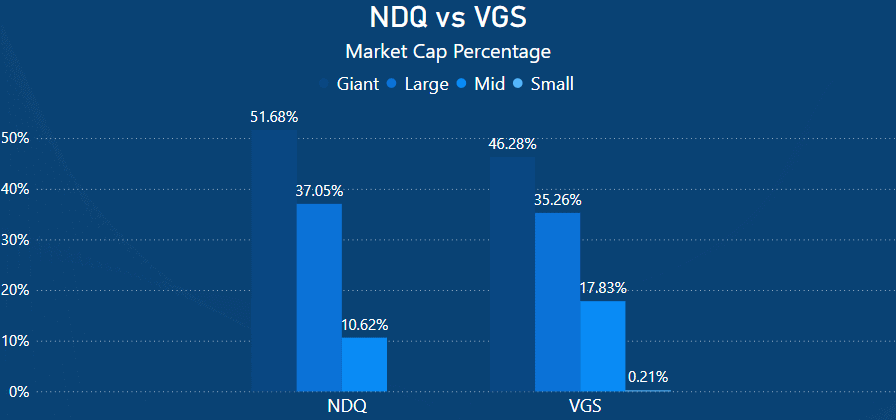
When comparing NDQ and VGS side by side, their distributions of giant, large, and mid-cap companies are very similar. VGS consists of 46.28% giant-cap companies, while NDQ has a slightly higher proportion at 52.68%.
This alignment is somewhat expected, given the heavy concentration of NDQ and its focus on the largest companies listed on the NASDAQ100.
When comparing large-cap companies, VGS comprises 35.26%, while NDQ is slightly higher at 37.05%. In terms of mid-cap companies, VGS has a higher allocation at 17.83%, whereas NDQ only has 10.62%.
Lastly, VGS holds a nominal amount of small-cap companies at 0.21%, while NDQ currently does not include any small-cap companies within its ETF.
Summary – Tech Stocks vs Global Diversification
When examining NDQ and VGS from an investment standpoint, they present starkly different profiles and mandates. Investing in NDQ entails opting for a relatively highly concentrated ETF with just 100 listings, predominantly focused on the tech sector.
Given the significant growth of this sector, particularly in 2023, share prices of these companies have reached all-time highs. Consequently, some investors may perceive these stocks as overvalued, at their peak, or ripe for a correction.
On the other hand, some view these companies as the future and foresee nothing but great prosperity on the horizon.
In contrast, VGS offers a vastly different picture, with nearly 1500 global companies in its portfolio. While VGS shares similar top 10 holdings with NDQ, it boasts diversification across various countries and sectors worldwide.
The decision to invest in either ETF ultimately hinges on individual financial goals, objectives, and risk tolerance. Both present valid investment opportunities, with VGS often serving as a “core” holding for many investors, while NDQ is increasingly gaining traction as a strategic tilt in portfolios.
However, for many investors, VGS provides a broader investment option, as a larger and more diversified ETF compared to NDQ, which lacks the same level of exposure.
This article does not serve as an endorsement or recommendation for products mentioned in the article. The information presented here is based on referenced sources and is accurate as of the date of 09 March 2024. Please note that these articles are written sometime before their publication date.
The information provided in this content is for informational purposes only and should not be considered as financial, investment, or professional advice. We recommend consulting with a qualified expert or conducting your own research before making any financial decisions.
The accuracy, completeness, or reliability of the information cannot be guaranteed, and the provider shall not be held responsible for any actions taken based on the information contained in this content.
References
- https://www.reuters.com/markets/us/sp-500-confirms-bull-market-with-record-close-2024-01-19/#:~:text=Jan%2019%20(Reuters)%20%2D%20The,first%20time%20in%20two%20years.
- https://www.google.com/finance/quote/NVDA:NASDAQ?sa=X&ved=2ahUKEwjkhZP68OyEAxWydfUHHccHBLwQ3ecFegQIPRAf&window=1Y
- https://au.finance.yahoo.com/
- https://www.morningstar.com.au/
- https://www.betashares.com.au/fund/nasdaq-100-etf/
- https://www.betashares.com.au/about-us/
- https://www.vanguard.com.au/corporate/
- https://www.vanguard.com.au/personal/invest-with-us/etf?portId=8212
- https://www.spglobal.com/spdji/en/indices/equity/sp-asx-200/#overview









